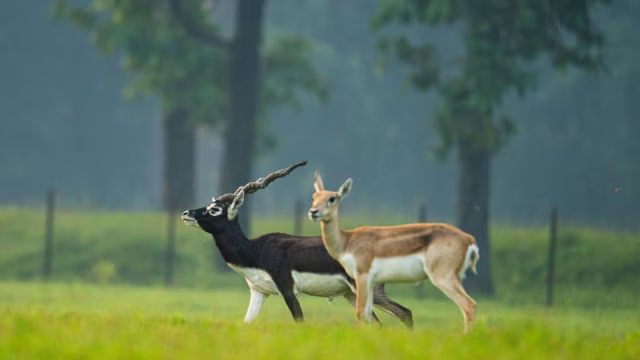Chhattisgarh Switch to Hindi
Revival of Blackbuck in Barnawapara Wildlife Sanctuary
Why in News?
Chhattisgarh’s Barnawapara Wildlife Sanctuary has successfully revived the blackbuck population nearly five decades after its local extinction, representing a significant milestone in India’s wildlife conservation efforts.
Key Points
- Reintroduction Initiative: The Chhattisgarh Forest Department initiated a five-year blackbuck reintroduction programme (2021–2026) aimed at restoring the species to its natural habitat.
- Translocation Effort: A total of 77 blackbucks were introduced — 50 from the National Zoological Park (Delhi) and 27 from Kanan Pendari Zoological Garden (Bilaspur).
- Population Recovery: From zero population in the 1970s, Barnawapara now hosts around 190 blackbucks, showcasing the success of the programme.
- Future Expansion: Encouraged by success, the forest department plans to extend the model to other sanctuaries, including Gomardha Wildlife Sanctuary (Raigarh), known for its ideal grassland ecosystem.
About Blackbucks
- About: The Blackbuck (Antilope cervicapra), or Indian Antelope, is a diurnal ( day-active) animal found in India (mainly in Rajasthan, Gujarat, Madhya Pradesh, Tamil Nadu, and Odisha) and Nepal,.
- It is regarded as the symbol of India’s grassland ecosystem.
- Key Blackbuck Habitats: Velavadar Blackbuck Sanctuary (Gujarat), Point Calimere Wildlife Sanctuary (Tamil Nadu), and Tal Chhapar Sanctuary (Rajasthan).
- Protection Status:
- Wildlife Protection Act, 1972: Schedule I
- IUCN Status: Least Concern
- CITES: Appendix III
- Threats: Habitat loss and fragmentation, deforestation, natural disasters, and illegal hunting pose major risks to the species.
About Barnawapara Wildlife Sanctuary
- Location & Name: It is situated in the northeastern corner of Raipur district, Chhattisgarh, and is named after the Bar and Nawapara forest villages at its heart.
- Terrain & Geography: Features undulating terrain with numerous low and high hillocks. Water sources include tributaries of the Mahanadi River, with River Balamdehi forming the western boundary and Jonk River the north-eastern boundary.
- Forest Type: The sanctuary has well-stocked forests, classified as teak, sal, and mixed forests.
- Wildlife: Commonly sighted animals include Indian bison (Gaur), Cheetal, Sambhar, Neelgai, and Wild boar.










.jpg)
.jpg)










.png)


.jpg)



 PCS Parikshan
PCS Parikshan


